|
Eyes of the Invasion
The Story of No.268 Squadron,
35(Recce) Wing
84 Group, Second Tactical Air Force
Royal Air Force on 6 June, 1944
by Colin Ford
Profile illustrations by
Juanita Franzi
|
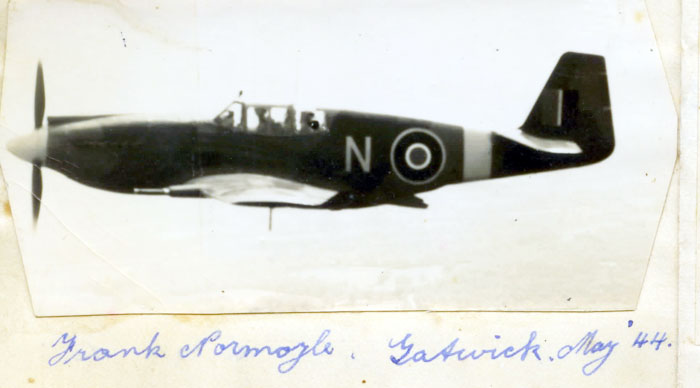 |
|
North American Mustang Mk.IA
FD552 ‘N’ flown by Flying Officer Frank Normoyle RAAF, photographed near
Gatwick in late May 1944 during flying training exercises in preparation
for D-Day. Photographed by Flying Officer Basil Rachinger RAAF flying
Mustang Mk.IA FD544 ‘V’. Note the cooling air outlet from the under
fuselage radiator assembly in the ‘down’ position. |
Based on the soon to be released history of No.268 Squadron, Royal Air Force,
“Adjidaumo – Tail In Air – The History of No.268 Squadron Royal Air Force 1940
to 1946”

HyperScale is proudly supported by Squadron
No.268 Squadron Royal Air Force was reformed at Westley in the UK on September
30, 1940 as an Army Co-operation Command Squadron flying Westland Lysanders. In
April 1941 the Squadron moved to Snailwell and soon after re-equipped with the
Curtiss Tomahawk. April 18, 1942 saw the Squadron receive the first of its
North American Mustang Mk.I aircraft, and the Squadron soon commenced operations
on the Mustang. In 1942 the emphasis was primarily on shipping reconnaissance
of the coast of Holland and in the northern section of the English Channel, ‘Jim
Crow’ and ‘Lagoon’ sorties, interspersed with number of offensive operations
over the Netherlands and western Germany, ‘Rhubarb’ sorties where they would
shoot up any targets of opportunity seen enroute. On October 21, 1942, the
Squadron flew the first ‘Rhubarb’ by single engined RAF fighter based in the UK
against targets in western Germany. The Squadron during this time was also
gaining experience with the use of the F.24 oblique reconnaissance camera fitted
behind the pilot’s head in the Mustang.
In
early 1943 the Squadron continued with its operations along the coast of the
Netherlands, the occasional ‘Rhubarb’ a few diversion sorties in support of RAF
bomber operations. In May 1943 a major change took place with the Squadron
commencing operations that would see them concentrate their efforts on France,
in particular the French Coast and all manner of German military installations,
bridges, major roads, railways from southern Belgium to the southern coast of
the Cherbourg peninsular. June 1943 saw the Squadron commence re-equipping with
the North American Mustang Mk.IA, the latest variant of the Mustang then
entering RAF service and armed with four 20mm cannon. In this time frame the
Squadron was also conducting tests with the fitment of a vertical camera in the
tail of the Mustang to permit overhead photography of targets, to supplement the
oblique photography already being obtained. The vertical camera installation
pioneered by the Squadron was adopted as the standard for the RAF Allison
Mustangs.
Early 1944 saw the Squadron attend an Armament camp at Llanbedr in Wales and a
Naval Gunnery Control Course at Dundonald in Scotland, as well as continuing a
concentrated program of specialist photography of beaches, German defence
installations and the French road and rail network. The emphasis on targets in
the area between Dunkirk and Cherbourg was maintained throughout that time,
although the area along the Normandy coastline between Trouville-sur-Mer and
Bayeux were subject to special scrutiny. The Squadron had been relocated to
Gatwick to join the other components units in 35(Recce) Wing, NoII(AC) Squadron
and No.4 Squadron. 35(Recce) Wing was tasked to operate in support of 1st
Canadian Army for the planned Invasion and afterwards. In May 1944 the Squadron
flew a number of special ‘urgent’ sorties, tasked to check the state of German
anti-invasion preparations along specified beaches in the Normandy region, and
to also check the state of anti-glider and anti-paratroop obstacles in areas
immediately behind the Normandy beaches.
By
the beginning of June 1944, the anticipation for the forthcoming invasion of
Europe was high, and preparations were complete.
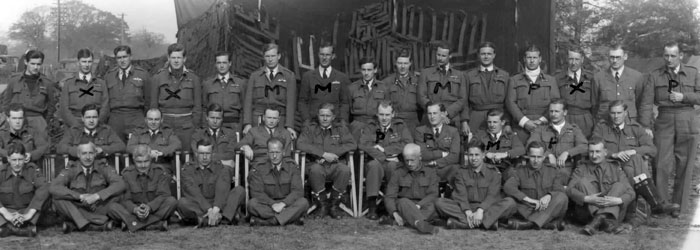
Members of No.268 Squadron Royal Air Force, photographed
at Gatwick in late May 1944, just before D-Day. Note the annotations made on
the photograph at the time indicating the fates of some of the pilots in the
photograph: X = killed, M = missing, P = posted. Unfortunately, a number of
those marked M, were eventually determined to have been killed in action, and
even some of those posted did not survive the War.
As
the fateful date of 6 June 1944 grew closer, those in the Squadron could not
miss all the signs that the date for the long awaited invasion of Europe was
close at hand. The heavy concentrations of military equipment and personnel in
southern England grew more intense every day. In the week leading up to D-Day,
the continual movement of convoys of military vehicles towards the invasion
embarkation ports could not be missed. In addition, the concentration of
paratroop aircraft, assault gliders and their tow aircraft on many airfields was
a sure sign of what was to come.
June 1, 1944
The
weather finally cooperated sufficiently that the long planned program of air to
air firing practice could take place. Three sections of three Mustangs were
dispatched. They made rendezvous with the target towing aircraft and then
escorted it into the firing range area. In turn each pilot made their practice
firing passes on the towed drogue and then returned individually to Gatwick. By
the time the final section rendezvoused with the target towing aircraft the
weather conditions had deteriorated and further firing was impossible.
At
the request of the Army, the Squadron conducted an Arty/R procedure practice
using six of the Squadron’s Mustangs and pilots. Flt Lt RJF Mitchell DFC of HQ
35 (Recce) Wing conducted an air test on one of the Mustangs. Sqdn Ldr Mann DFC
conducted a camera test on the Hawker Typhoon.
Three new pilots were posted to the Squadron, Flt Lt FG ‘Pluto’ Barber. Flg Off
GWG ‘Bucky’ Buckland and Flg Off WG ‘Wally’ Creevy. Flt Lt Barber already had
an association with the Squadron dating back to 1940 and 1941, when as an Army
Officer he had been taken for a number of Air Experience flights in the
Squadron’s Westland Lysanders when they were based at Westley.
June 2, 1944
Six
pairs of Mustangs stood by for operations from very early in the morning until
early evening, when four of the pairs were released. The final two pairs of
Mustangs were not released until very late in the evening. As such there was no
operational activity for the day.
Flg
Off Garside made an air test on one of the Mustangs, and Flt Lt Lissner combined
an air test with some oblique photography practice.
Sqdn Ldr Mann made a cross country flight to Llanbedr where he landed with
hydraulic failure.
New
was received during the day that Squadron Leader AS Mann and Flg Off DM Ashford
had both been given the immediate award of the Distinguished Flying Cross for
their actions on their mission over Boulogne of May 24, 1944. The official
notification would not appear in the London Gazette until June 23, 1944.
Saturday June 3, 1944
The
air to air firing program was recommenced during the day. Again three sections
of three Mustangs conducted firing practice against a towed drogue, and again
the last section met deteriorating weather conditions requiring the cancellation
of the last session. Flt Lt Barber, Flg Off Buckland and Flg Off Creevy all
made local familiarisation flights, combined with pinpoint photography
practice. Flg Off Garside conducted a flight test of one of the Squadron’s
Mustangs, and Sqdn Ldr Mann DFC was able to return from Llanbedr after temporary
repairs had been completed on Mustang W.
Gp
Capt Donkin and the 35 (Recce) Wing Intelligence Officer, Sqdn Ldr Laurence
Irving, attended a conference at 2TAF Headquarters at Uxbridge, where Air
Marshal Sir Arthur Coningham opened the conference to the packed room with the
words, “Gentlemen, we are now at D minus two!”. D-Day was thus
originally set for Monday June 5, 1944. This naturally enough produced a massed
intake of breath which was rapidly followed by mixed feelings of anticipation of
what was to come, and relief that “the day” was soon to be upon them. Following
the conference presentations which outlined the overall strategies and
arrangements for D-Day, the signing for and receipt of information packages, Gp
Capt Donkin and Sqdn Ldr Irving returned to the Wing’s base at Gatwick, where
key personnel, including the Commanding Officers of the three Squadrons, 2, 4
and 268, were appraised of the situation. Arrangements had to be quietly put in
place to ensure all aircrew and aircraft were ready for a maximum effort on
D-Day.
June 4, 1944
Three
pairs of Mustangs were on standby for operations from 07.00 hrs, with another
three pairs being required on standby after 08.15 hrs. Eventually only one
operational Photographic Reconnaissance sortie was flown for the day.
Flt
Lt Woodward in FD506 A and Flg Off Bradford in FD546 G were finally briefed at
16.00 hrs for a photo reconnaissance of RDF installations south west of Etrat/Cap
D’Antifer. The briefing was unusually long and comprehensive as they were to
use the new compensating camera variant of the F.24, which required exact
speeds, distances and heights to be attained and maintained during the photo run
in order to achieve the best results. They took off at 18.30 hrs and arrived
over the target area without incident. A large amount of flak was experienced
by the two aircraft around the target area, but neither was hit and they both
safely returned to base with the required photography. Flt Lt Woodward’s
Mustang developed some engine troubles on the return flight but they were not
serious.
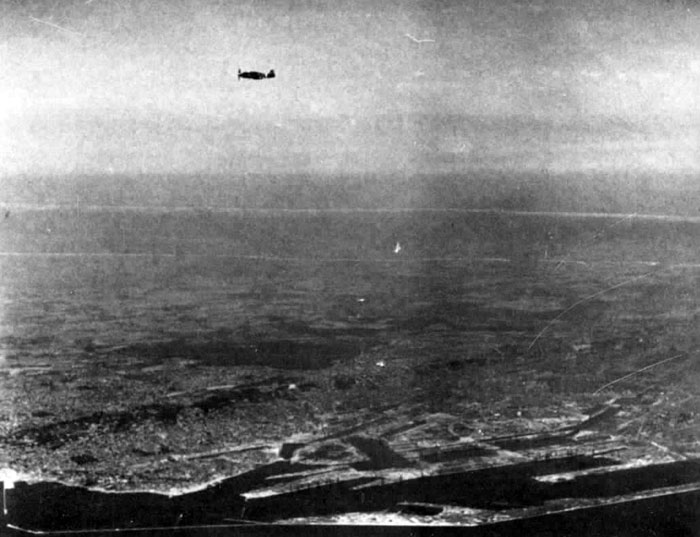
Photograph
taken not long before D-Day of one of No.268 Squadron’s Mustang Mk.IA aircraft
during a reconnaissance sortie along the French coast, photographing beaches,
invasion obstacles and other targets of interest.
June 5, 1944
This
was a comparatively
quiet day. Flying training was conducted during the day, eleven sorties
including air tests, pairs flying and photographic practice being conducted
without incident. Poor weather conditions over southern England and western
France, which included high winds, low cloud and rain, had forced the
postponement of the invasion for 24 hours, with a predicted change in the
weather to more suitable conditions for June 6, 1944.
On
the evening of June 5 1944, the Squadron’s pilots were informed by Gp Capt
Donkin that the invasion would begin at midnight with the first waves of
airborne forces soon to be on their way, and that the seaborne invasion forces
would land at first light the following morning. All personnel were confined to
camp, and spent a listless night listening to the drone of paratroop aircraft,
glider tugs and heavy bombers passing overhead on their way to France. For
those on the Squadron, the final sign was the Squadron’s Mustang aircraft being
marked with the black and white invasion stripes to assist in the recognition of
Allied aircraft over the invasion area. Distinct to other Allied air units, the
low level tactical reconnaissance squadrons had received a dispensation
regarding the extent to which they would carry the black and white invasion
stripes. Whilst most other aircraft were required to carry the black and white
invasion stripes fully encircling the fuselage and wings of the aircraft, in
order not to compromise the effectiveness of the camouflage worn by the Mustangs
when operating at low level. So they were only required to paint the invasion
stripes on the under surfaces of the rear fuselage and under both wings where
they would be most visible to Allied naval forces and ground troops. The Wing
HQ had put in place arrangements for the timely and neat marking of the Wing’s
aircraft with the required identification stripes with all Wing aircraft being
painted and ready well in time for the following day’s operations.
For
some, the lead up to D-Day and its timing came as a bit of a surprise, as Flt Lt
RJF ‘Mitch’ Mitchell recalls:
“I was ‘on rest’ during the D-Day
activities but my wife and I were enjoying a forty-eight hour leave in ‘The
Wagon Shed’, just outside Gatwick, (sadly no longer there) on the two days prior
to D-Day and the only member of the Squadron we saw on the evening of 5th June
was Bas Rachinger!! We guessed something ‘was up’ so Sue hitched an early ride
back to ‘Bentley Priory’, where she was a Plotter in the Fighter Command HQ Ops
Room, and I high-tailed it back to base in time to take over an early stint in
the 35 Wing ‘Ops’ Room (read ‘Caravan’!) and later dig a slit-trench for my camp
bed! We went on that two day's leave without an inkling of the fact that D-Day
was so imminent and the C.O. didn't bat an eyelid when he signed my pass
although he was fully aware of what was going to happen.”
For
D-Day the Squadron flew its first operations for the day from Gatwick and then
moved to RNAS Lee-on-Solent as a part of the “Fleet Spotting Pool”. They were
tasked in the morning with naval gunfire spotting for British Home Fleet Units
operating in support of the landing forces and reconnaissance photography of the
invasion beaches. All aircrew were up and active at 03.30 hrs for briefings and
preparations. The detailed briefings for the naval gunfire spotting sorties
were given by Captain Parish RN and Captain Wilson RN. The first three pairs
took off for naval gunfire spotting at 05.00 hrs, with a further five pairs
following at 05.50 hrs. Three remaining aircraft were flown to Lee-on-Solent
from where operations would continue.
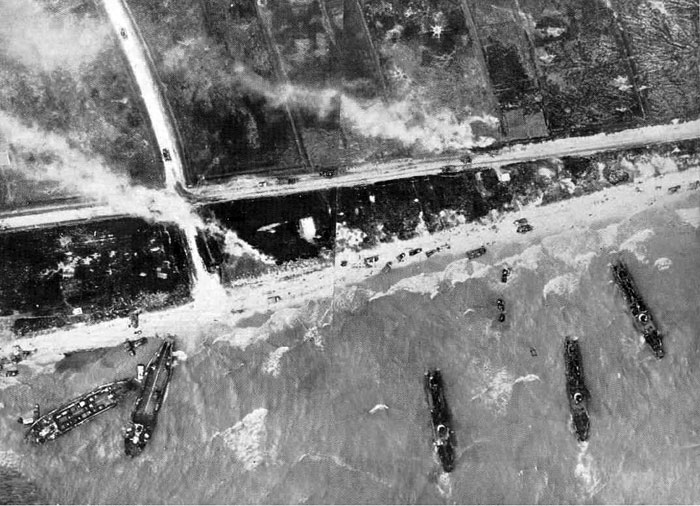
Photograph
taken by one of the sorties flown by No.268 Squadron on D-Day of the Allied
landings at Anselles. Note that the photograph is actually a composite of two
overlapping photographs, the overlap point being down the centre of the
photograph. Note also the vehicles moving away from the beach area on the road
towards the top of the photograph.
Flg
Off Clarke in FD562 C and Flg Off Cullen in FD546 G took off at 04.55 hrs for a
naval shoot. Their first shoot was successful but the second failed due to
weakening radio contact with the naval vessel. They encountered intense and
accurate heavy flak whilst over the invasion area.
Flt
Lt Lissner in FD506 A and Flg Off Rachinger in FD476 B took off at 05.00 hrs for
a naval shoot. They arrived over the area to find their targets had already
been neutralised and therefore conducted an impromptu shoot with their assigned
naval units.
Flg
Off Gibson RCAF in FD507 H and Flg Off Bradford in FD498 J took off at 05.00 hrs
for a naval shoot. Both their shoots were very effective. They encountered
intense and accurate heavy and light flak whilst over the invasion area.
Flt
Lt Reahil in FD486 H and Flt Lt Lewis in FD552 N took off at 05.45 hrs for a
naval shoot. Their first shoot was very successful with the target being
destroyed, but their second had to be aborted as the target was obscured by
heavy smoke.
Flg
Off Conway RCAF in FD561 O and Flg Off Lavender in FD549 took off at 05.50 hrs
for a naval shoot. Their first target was destroyed but the second target was
not engaged by the ship.
Flt
Lt Woodward in FD495 R and Flt Lt Boughey in FD541 T took off at 06.00 hrs for a
naval shoot. No shoots took place as the targets were obscured by heavy smoke.
They encountered intense and accurate light flak, some of it believed to be
coming from Allied naval vessel below them despite the identifying invasion
stripes on the aircraft’s undersides.
The
Squadron’s one recorded loss for D-Day, was Mustang Mk.IA FD495 R flown by Flt
Lt ED Woodward, which is recorded as missing, having failed to return from a
naval gunfire observation tasking over the invasion area.
He called in by radio to the airfield at Gatwick to
report engine trouble over Ouistreham, but failed to return. It is possible
that Flt Lt Woodward’s Mustang may have been hit by some of the flak reported as
being encountered on that sortie by Flt Lt Boughey.
Flt Lt ED
Woodward has no known grave and is recorded on the Runnymede Memorial in
Sussex.
Flg Off
Yearwood in FD544 V and Flg Off Lloyd in FD557 Z took of at 06.00 hrs for a
naval shoot. No targets were engaged as the ship had already engaged and
destroyed the targets before the aircraft arrived.
Gp Capt
Donkin DSO in FD471 E and Flt Lt Tuele RCAF in FD472 M took off at 05.30 hrs to
conduct a visual observation of the invasion beachhead area. Intense and
accurate light and heavy flak was encountered during the time the aircraft were
in the beachhead area.
Flt Lt
Lissner in FD506 A and Flg Off Rachinger RAAF in FD476 B took off from
Lee-on-Solent at 08.25 hrs for a second naval shoot. The planned targets had
already been neutralised by the naval bombardment by the time the aircraft
arrived on station, and they were requested to perform an ad-hoc Tac/R of Port
En Bassin by the French ships they were in contact with.
Flg Off
Gibson RCAF in FD486 H and Flg Off Bradford in FD498 J took off at 08.30 hrs
from Lee-on-Solent for a second naval shoot. They directed the naval
bombardment onto an enemy shore battery that was engaged and partially
destroyed.
Flg Off
Clarke in FD562 C and Flg Off Cullen in FD480 G took off at 08.40 hrs from
Lee-on-Solent for a second naval shoot. Neither of the original targets they
had been briefed for was engaged, however they conducted an impromptu shoot with
the Naval vessels on two other targets which were successful.
Flg Off
Yearwood in FD544 V and Flg Off Lloyd in FD501 Z took off at 09.25 hrs from
Lee-on-Solent for a second naval shoot. Neither target they were originally
briefed for were engaged, however an impromptu shoot on enemy heavy mortar
positions was successfully conducted. Flg Off Lloyd recorded the details of his
two sorties for the day in his log book:
“’D’ Day.
Up at 03.30 it was raining but soon cleared. Airborne in the first wave at
05.50 led by F/O Yearwood ‘Earwig’ out E of Brighton and to the invasion coast
Normandy? We completed the shoot and returned to Lee-on-Solent, had a cup of
tea and off again. I could not start so ‘Earwig’ went on and I met him over the
tgt at a/b +30. The whole show was perfect. A sight I shall not forget. The
Army and Navy were bang on. No flak. ‘Woody’ F/Lt Woodward missing, probably
hit off Le Havre.”
Flg Off
Conway RCAF in FD561 O and Flg Off Lavender in FD535 X took off at 09.30 hrs
from Lee-on-Solent for a second naval shoot. Neither briefed target was engaged
due to R/T failure. Intense inaccurate light flak was reported coming from the
target area and units of the Royal Navy.
Flg Off
Boughey in FD541 T and Flg Off Garside in FD(SIR) D took off at 09.30 hrs from
Lee-on-Solent for a second naval shoot. Neither briefed target was engaged as
they had already been neutralised by naval bombardment and they were directed to
return to base. Slight heavy flak was reported in the area.
Sqdn Ldr
Mann DFC in FD447 and Flt Lt Tuele RCAF in FD472 M took off at 09.25 hrs for a
sortie over the beachhead area to direct naval gunfire onto two targets west of
Trouville,
being German coast defence batterys in large concrete bunker emplacements. The
naval bombardment was very accurate, with direct hits on both targets. Upon
request by the HQ ship an impromptu Tac/R was conducted covering the
Trouville-Caen area to report on Allied and enemy movements.
As
the aircraft were refuelled, rearmed and had any problems that had arisen during
the early morning sorties rectified, the pilots debriefed with the ALOs and
intelligence officers. Just after lunch time, a BBC Radio recording team
arrived and recorded interviews with selected pilots, capturing their
impressions of the events they had seen earlier in the day.
In
the afternoon the Squadron was retasked with tactical reconnaissance in the
areas behind the invasion beaches, looking for German reinforcements being moved
into the area, with the naval gunfire spotting task being continued by other RAF
and Fleet Air Arm units flying Spitfires and Seafires. The Squadron’s aircraft
brought back the required information including photographs showing the extent
of the Allied beachhead and lack of movement from any German reinforcements
trying to move forwards towards the beachhead.
Flt Lt
Brown RCAF in FD506 A and Flt Lt Hall in FD546 G took off at 19.25 hrs to
conduct a Tac/R well behind the beachhead area covering Caudebec – Rouen –
Gisors – Gournay – Serqueux – Neuf Chatel, to look for any signs of German
reinforcements being moved to the invasion area. Surprisingly there was little
movement noted.
Flt Lt
Reahil in FD476 B and Flg Off Smith RCAF in FD471 E took off at 19.40 hrs to
conduct a Tac/R of a railway junction to the south of Paris, again to check for
any movement of enemy reinforcements. Again there was no unusual or significant
movement noted.
Flg Off F
Jenkins RCAF in FD552 N and Flg Off Garside in FD557 Z took off at 19.38 hrs to
conduct a Tac/R of road and rail junctions near Coutences – Perier – Carentan –
Lessay, checking for any signs of enemy movement. There was no significant
activity noted. Flg Off Garside noted in his log book: “No flak & no
movement seen. Very weird.”
Sqdn Ldr Mann DFC recalls the momentous day:
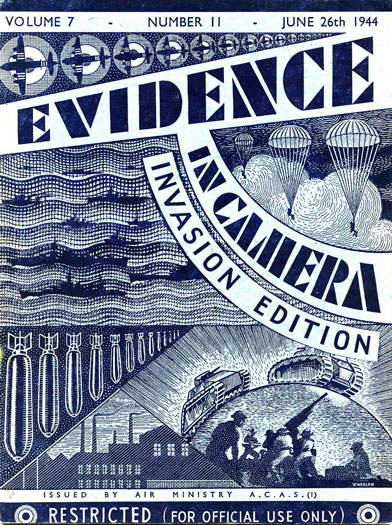 “’D’
Day was upon us quite suddenly. Early naval gunfire direction sorties were
briefed at Lee-on-Solent, and we flew there at ‘first light’. All the ‘brass’
were at the top table and, among the multitude of all three services, our little
group were very proud indeed to be there. Bill Tuele (Can) was my no.2, and
after the main briefing we were taken through the detail of our individual
shoots by very convincing naval experts who also made it clear that we should
make our sea crossing at 4,000 ft, not the usual wave-top height, because the
ships were going to be ‘trigger-happy’ – ie. they would take exception to any
aircraft approaching at sea level!! We were airborne at once; set off to the
south, and there it was – a fine view of tremendous activity. Ships, ships,
ships and small craft as far as the eye could see in any direction, their wakes
pointed southwards. Many thousands at the start of the greatest sea-borne
invasion in the history of the world!! It was the sensation of a life-time!!
There were one or two ‘puffs’ on track to our rendezvous, but nothing of
concern. We found the ships – made contact, and set about the morning’s work.
Two coastal gun emplacements near Trouville were the targets allocated to my
section. After a couple of good sighting shots out guns were on number one
target, and the first salvo straddled it – others followed. The second
emplacement got similar treatment. Big guns really are the best and the Navy
were certainly on form! My happy calls of congratulations were returned in calm
and measured tone with a single word of thanks and we were back off to
Lee-on-Solent, airborne for two and a half hours. After a satisfactory
de-briefing, a short rest and a sandwich we were back to Gatwick in twenty
minutes. Most of the Squadron had a ‘look in’ on this day – we had been waiting
for a long time. Now the first hurdle was behind us and everything seemed to be
going well on the ground. ‘D’ Day was a success for the Squadron, but marred by
the loss of a Mustang with a most experienced and valued member of the team.” “’D’
Day was upon us quite suddenly. Early naval gunfire direction sorties were
briefed at Lee-on-Solent, and we flew there at ‘first light’. All the ‘brass’
were at the top table and, among the multitude of all three services, our little
group were very proud indeed to be there. Bill Tuele (Can) was my no.2, and
after the main briefing we were taken through the detail of our individual
shoots by very convincing naval experts who also made it clear that we should
make our sea crossing at 4,000 ft, not the usual wave-top height, because the
ships were going to be ‘trigger-happy’ – ie. they would take exception to any
aircraft approaching at sea level!! We were airborne at once; set off to the
south, and there it was – a fine view of tremendous activity. Ships, ships,
ships and small craft as far as the eye could see in any direction, their wakes
pointed southwards. Many thousands at the start of the greatest sea-borne
invasion in the history of the world!! It was the sensation of a life-time!!
There were one or two ‘puffs’ on track to our rendezvous, but nothing of
concern. We found the ships – made contact, and set about the morning’s work.
Two coastal gun emplacements near Trouville were the targets allocated to my
section. After a couple of good sighting shots out guns were on number one
target, and the first salvo straddled it – others followed. The second
emplacement got similar treatment. Big guns really are the best and the Navy
were certainly on form! My happy calls of congratulations were returned in calm
and measured tone with a single word of thanks and we were back off to
Lee-on-Solent, airborne for two and a half hours. After a satisfactory
de-briefing, a short rest and a sandwich we were back to Gatwick in twenty
minutes. Most of the Squadron had a ‘look in’ on this day – we had been waiting
for a long time. Now the first hurdle was behind us and everything seemed to be
going well on the ground. ‘D’ Day was a success for the Squadron, but marred by
the loss of a Mustang with a most experienced and valued member of the team.”
From the diary of Flg Off Basil Rachinger RAAF, comes this first hand account of
the 5th and 6th of June 1944.
June 5 Mon
No flying – preparing for “D” day which appears to be getting rather close. –
Gee! at 8 PM the G/Capt Donkin told us our role & D day is to commence at
daybreak tomorrow. Uncertain thoughts on the future. Confined to camp.
June 6 Tues
Slept a very troubled sleep being awakened at 3.30 AM by the batman. Sweat was
pouring out of me. Breakfasted at 4 AM, airborne at 5 AM. With Maurice Lissner
controlled the bombardment of enemy coastal defences by HMS Montcalm 9 x 6” just
prior to the initial landings – Port en Bassin (2000’ – 1hr 20 over target) Had
box seat view of whole proceedings which looked remarkably under control – also
not a Hun in the sky – bags of flak and our own boys though. Quite impressive
watching utter hell let loose on both sides. Ack ack, coastal guns, rockets
galore, ariel bombing, naval bombardment etc & thousands of ships across the
Channel as far as the eye could see. Shell holes, water spouts, smoke, flames,
smoke screens, debris etc, added impressiveness to the proceedings. Destroyer
sunk, battleship hit, L.C.A. vanished leaving dirty mark in the water, Spit in
death dive, E boats in Bassin blazing furiously, town razed to ground level,
aircraft burning on ground. Flew second sortie from Lee on Solent, near
Southhampton, at 9 AM. (55 minutes over invasion area) Hun coastal resistance
ceased, barges now on a regular shuttle service to and from the beach. Did a
Tac/R trying to find targets for more Naval Bombardment but without success.
Flew 5 hours between 5 AM + 11 AM when we returned to base – happy but very
tired. Eric Woodward is our only pilot missing. They think he baled out
amongst the barges. Stood down at 10 PM, then to bed. “D” day is over.
Port-en-Bassin mentioned in his narrative, was a small French port that was at
the juncture of the British and American landing zones, between Gold and Omaha
beaches. It was the scene of a lively exchange of gunfire between Allied naval
units offshore (including the French cruisers Montcalm and Georges Leygues, US
destroyers USS Emmons and USS Doyle, US cruiser USS Augusta, and US battleship
USS Arkansas), German coastal batteries and a German Flak ship anchored in the
port that saw the village devastated.
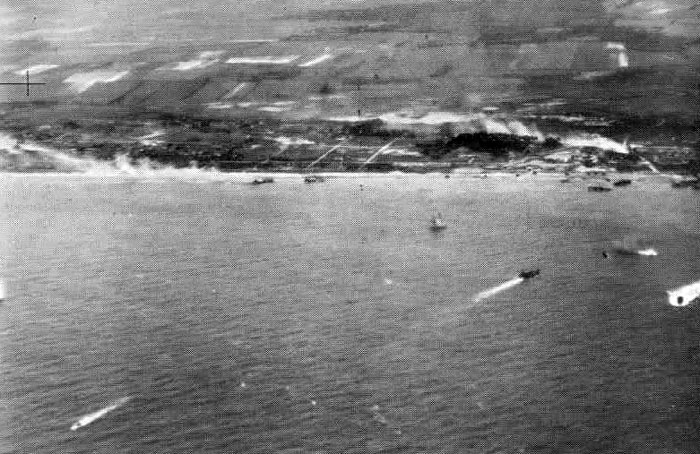
Photograph of the Invasion beaches – Gold Beach - taken by a pilot from No.268
Squadron at 1000hrs on June 6, 1944. The photograph shows the coast at
Ouistreham. Smoke from the bombardment and battle for the beaches can be seen
along the shoreline. Naval landing craft are seen shuttling to and from the
landing beaches bringing in reinforcements and supplies to support the first
wave of Allied troops ashore. Instead of the usual ‘zero’ feet the Squadron had
been photographing this area, due to the requirement to avoid Allied naval anti
aircraft fire, operations over the invasion fleet and immediate beach head area
had to be conducted above 4,000 ft. Once beyond the immediate beach head area
and inland, pilots could descend to below 1,000 ft above ground level to conduct
their sorties.
All
of the Squadron’s pilots brought back with them their own images of the
Invasion, both photographic and locked away in their memory. Each had their own
‘front row seat’ view of the invasion as it took place beneath them. Most had
vivid memories of the impact of naval gunfire that they had directed onto the
Invasion beaches just before the landing took place, and then the direction of
the naval gunfire onto remaining pockets of resistance. Others remembered the
effects of the German’s defences, with landing craft destroyed and crippled, and
of the waves of Allied aircraft prowling over the Invasion fleet awaiting some
reaction from the Luftwaffe. More than one pair of the Squadron’s Mustangs had
to avoid the attentions of the masses of Allied fighters over the beach head,
their lack of invasion recognition stripes on their upper surfaces requiring
closer inspection and confirmation of their friendly status.
As
quickly as the aircraft landed, the cameras were stripped of their exposed film
magazines, reloaded with fresh film magazines, refuelled, re-armed if necessary,
whilst the pilot’s were debriefed by the intelligence officers on what they had
seen. A cup of tea, a quick cigarette, a hot bacon sandwich, and then pouring
over the fresh, wet prints straight from the mobile film processing unit, to
pick out possible targets for future sorties and point out features of interest
to the intelligence officers. A quick briefing from the intelligence officers
on the next sortie, maybe a quick word with the CO or the Flight Commander, some
flight planning with the maps and charts, calculating the headings, the
distances, the time at a given airspeed between each point, areas to avoid, and
then it was back to the aircraft. A quick stop to relieve oneself before
strapping back into the aircraft, then start engine and on the way for the next
sortie over the beachhead.
The
following few days saw the Squadron flying sorties at the highest rate possible,
in order to bring back information on the movements of German reinforcements
trying to get through to the beachhead. Many times the Squadron aircraft
returned with photographs that led to the dispatch of rocket firing Typhoons,
medium or heavy bombers to disrupt the German’s reinforcement efforts. A number
of aircraft returned to base showing the scars of clashes with the German
defences, the Luftwaffe at this stage starting to make its reappearance over the
battlefront, but the greatest threat still remaining that from enemy flak. The
Squadron’s aircraft added their own share to the German’s woes, letting loose
with the Mustang’s four 20mm cannon where appropriate, especially against German
troop and supply transports.
For
a number of the Squadron’s personnel who were ‘on rest’ from operations,
including Flt Lt OR Chapman DFC RNZAF, Flt Lt AR Hill DFC, Flt Lt EJ Milne DFC
and Flt Lt RJF Mitchell DFC, to be stuck in a training or headquarters posting
at the time of the invasion was particularly galling. They all recorded
notations against the momentous day in their pilot’s log books or diaries
expressing the general sentiment that they would have all preferred to be flying
operationally rather than fulfilling their current roles. Flt Lt Milne DFC
noted in his log book the disgust at being ‘on rest’ as the invasion commenced:
“On Rest 41 OTU Poulton – Invasion started. It would!!”
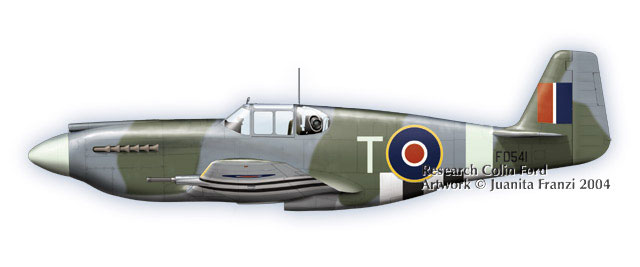
Colour profile of North American Mustang MkIA FD541 T of
No.268 Squadron, RAF, as it would have appeared on D-Day, June 6, 1944. Profile
by Juanita Franzi. ©
June 7 1944
eleven pairs of Mustangs were dispatched during the day for Tactical
Reconnaissance sorties. The primary purpose of all these sorties was to check
for the movement of any German reinforcements towards the beachhead area. There
was no significant enemy movement sighted during the sorties conducted during
the morning, whilst those in the afternoon and early evening saw a higher level
of ground activity and also an appearance by four possible Me-109s by one
sortie. The German flak during the afternoon sorties was also much more active,
with heavy flak being received from a number of locations.
One
notable sortie for the day was that by Flg Off Rachinger RAAF in FD506 A and Flg
Off Normoyle RAAF in FD544 V who took off from Gatwick at 12.00 hrs to conduct a
Tac/R covering Trouville – Lisieux – Evreux – Bernay - Trouville. They were
separated over the coast due to thick cloud cover, but Flg Off Rachinger RAAF
went on and on the way shot up five trucks loaded with German troops,
reconnoitred Evreux airfield with no enemy aircraft present there, then
encountered light flak near Bernay. Flg Off Rachinger RAAF noted in his diary
at the time the details of the sortie: “Sqdn doing tac/R sorties commencing
at 5.30AM. I got airborne with Frank Normoyle my No.2 at midday. Crossed out
of Eng at Selsey Bill instead of usual Beachy Head exit and made landfall at
Trouville across the Seine estuary from Le Havre. Cloud was at 1500’ up to 3000
& 10/10ths so had to stooge under it. Frank lost me just after crossing in so I
went on alone. Found trains galore at Lisieux which I photographed – town
burning – on to Evreux where I found 5 truck loads of Hun troops who sure
scattered pronto when I turned four cannon onto them. I knocked over quite a few
of them & peppered the trucks, I wish Frank could have been there to add fire
support. Procedeed onto Bernay, then back to Trouville without further
incident, except some meagre flak from Bernay 50 min inside. Met Frank at
Base. Sky was full of fighters, but luckily they were ours. No more jobs
forthcoming so a bunch of us walked into Horley to the pics & saw Tommy Handly
in ‘Time Flies’, mad but good fun.”
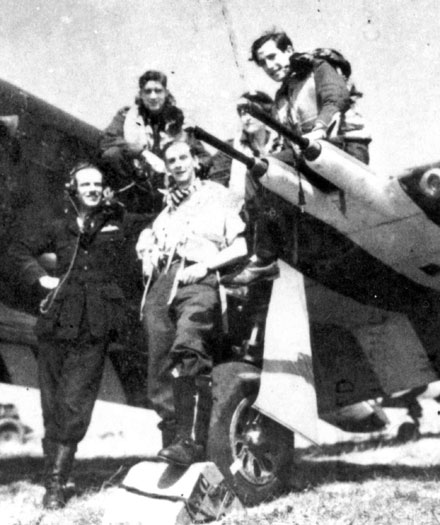 Squadron
pilots take time out to be photographed near one of the Squadron’s North
American Mustang Mk.IA aircraft. There photographs were most probably taken at
Odiham in July 1944, before the Squadron moved to France. Pilots shown with the
aircraft above are: on wing (left to right) Flg Off BFN Rachinger RAAF, Flg Off
AT Lord, Flg Off GKN Lloyd, on ground Flg Off FR Normoyle RAAF, Flt Lt FG
Barber. Note the fairly neat black and white invasion stripes painted under the
wing including up under the fairing for the cannon. Squadron
pilots take time out to be photographed near one of the Squadron’s North
American Mustang Mk.IA aircraft. There photographs were most probably taken at
Odiham in July 1944, before the Squadron moved to France. Pilots shown with the
aircraft above are: on wing (left to right) Flg Off BFN Rachinger RAAF, Flg Off
AT Lord, Flg Off GKN Lloyd, on ground Flg Off FR Normoyle RAAF, Flt Lt FG
Barber. Note the fairly neat black and white invasion stripes painted under the
wing including up under the fairing for the cannon.
Thus ended No.268 Squadron’s D-Day and D+1.
The next months would see them fly intensive tactical reconnaissance sorties at
low level in support of the 1st Canadian Army as it advanced across the
Continent. Some of the more striking reconnaissance photographs that had been
taken by the Squadron’s pilots and aircraft in the lead up to the Invasion and
afterwards would find their way into the RAF publication ‘Evidence in Camera’,
the classified record of the RAF’s photographic reconnaissance successes. In
mid July 1944 the Squadron started to receive the first of their Hawker Typhoon
FR-1b aircraft, to become the RAF’s only large scale user of the type. The
Typhoons would prove not to be entirely suitable for the Squadron’s role and
would be retired by November 1944. The War would eventually end with the
Squadron based at Celle, flying primarily Supermarine Spitfire FR.XIVEs with a
number of their long serving Allison engined Mustangs still being used daily for
operational sorties. They would retire the last of their beloved Mustangs in
August 1945.
|
Eyes of the Invasion in 1/48 scale |
Using the Accurate Miniatures 1/48th scale model of the Allison
engined North American Mustang Mk.IA as used by the RAF, these two models have
been built in the representative camouflage schemes and markings of two aircraft
from No.268 Squadron RAF in 1943 and 1944.
Firstly, FD507 H which commenced serving with the Squadron in July 1943, and was
still serving operationally with them on D-Day. FD507 is shown as when it was
flown with the Squadron in August 1943.
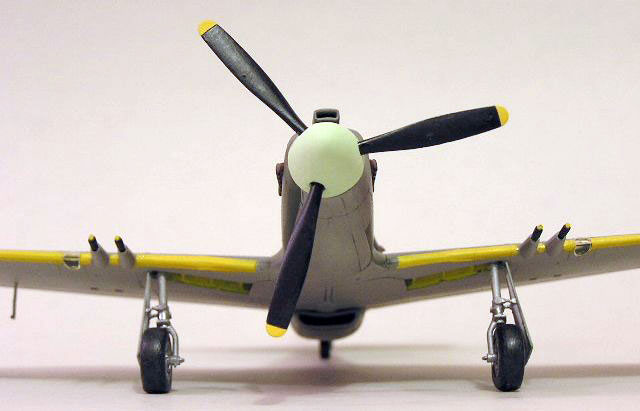
Click the
thumbnails below to view larger images:
Secondly, FD535 X which commenced serving with the Squadron also in 1943, and
would be with them into early 1945. X was one of a number of Mustangs equipped
with the vertical camera installation pioneered by the Squadron for use by the
RAF, and flew sorties on D-Day. Here X is shown with the marking scheme for the
Squadron’s aircraft worn for D-Day.
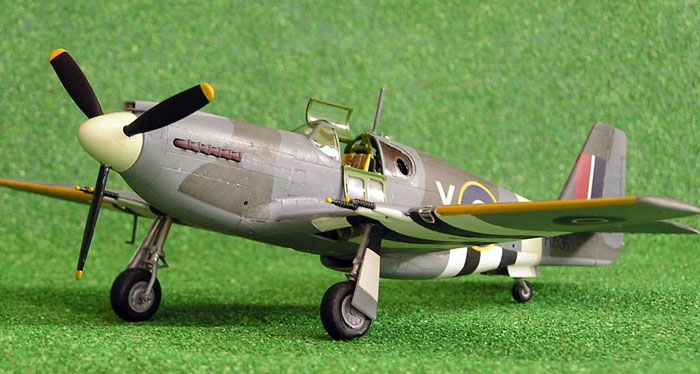
Click the
thumbnails below to view larger images:
Both models have been based on photographs of the subject and other Squadron
aircraft which are held in the authors collection and that will appear in
“Adjidaumo – Tail-In-Air”.
The D-Day Companion
General Military |
|
|
|
|
Author: 12 world-leading historians
US Price: $29.95
UK Price: £20.00
Publisher:
Osprey Publishing
Publish Date:
April 26, 2004
Details: 288 pages; ISBN: 1841767794 |
|
|
Text & Images Copyright ©
2004 by Colin Ford
Profile Illustrations Copyright ©
2004 by Juanita Franzi
Page Created 04 June, 2004
Last Updated
06 June, 2004
Back to Reference Library
|
Home |
What's New |
Features |
Gallery |
Reviews |
Reference |
Forum |
Search